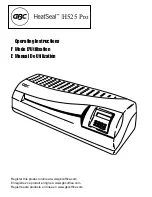
1
PHOTOPOLYMER DRY FILM LAMINATOR
OPERATING INSTRUCTIONS
WORK ROOM LIGHTING
Room lighting is most important and Philips TL 65 W 16 striplights are suitable for room lighting as their
spectrum has no effect on most photoresists. Windows should be covered with non – bleaching yellow foil
which cuts out light wavelengths under 450 nm., yellow foil can be obtained from the Kodak company and
Plexiglas type “ YELLOW 303 “ is equally suitable. Processing should be carried out under dust free
conditions, the laminated and exposed parts must also be stored in yellow light until used.
THE LAMINATOR
The laminator uses two rolls of Photo-resist, and only two rolls of the same width can be used up to 305 mm in
width for the MODEL 305 and 610 mm for the MODEL 610. The dry film photo emulsion is sandwiched
between a polyester cover sheet and a peelable polyofin sheet. The laminator removes the polyofin cover sheet
before the film contacts the heated rollers; these rollers then fuse with heat and pressure the photo emulsion on
to the material both sides. On exit the rear cold pressure rollers continue to roll and fix the photo emulsion
onto the material.
FILM LOADING AND THREADING
WHEN LOADING FILM USE IN CONJUCTION WITH THE FILM THREADING DIAGRAM page 5 or 6
TOP LOADING AND THREADING
1.
Remove the feed table and raise the safety guard.
2.
Remove the top polyofin take up roller shaft.
3.
Remove the top film supply roller shaft.
4.
Fit one of the spare cardboard tubes between the two core supports of the top polyofin take up roller shaft.
5.
Fit one of the DRY FILM rolls between the two core supports of the top supply roller shaft.
6.
Replace the top supply roller shaft with roll of film onto the machine, the round bearing end fits in the
side with the steel spring clip first and the hexagon end fits into the hexagon film tension socket. Ensure
the film roll is loaded the correct way, film dropping off the back of the roll.
7.
Replace the top polyofin take up roller shaft.
8.
Adjust the lateral position of both dry film roll and cardboard tube to align with each other.
9.
Remove the end of the top polyofin film and thread up the top section as per the threading diagram and
stick the edge of the polyofin film to the top take up roller tube with masking tape across the tube width.
10.
Roll both rolls together to allow excess film to feed behind the guard and below the centre line of the two
heat rollers.





















